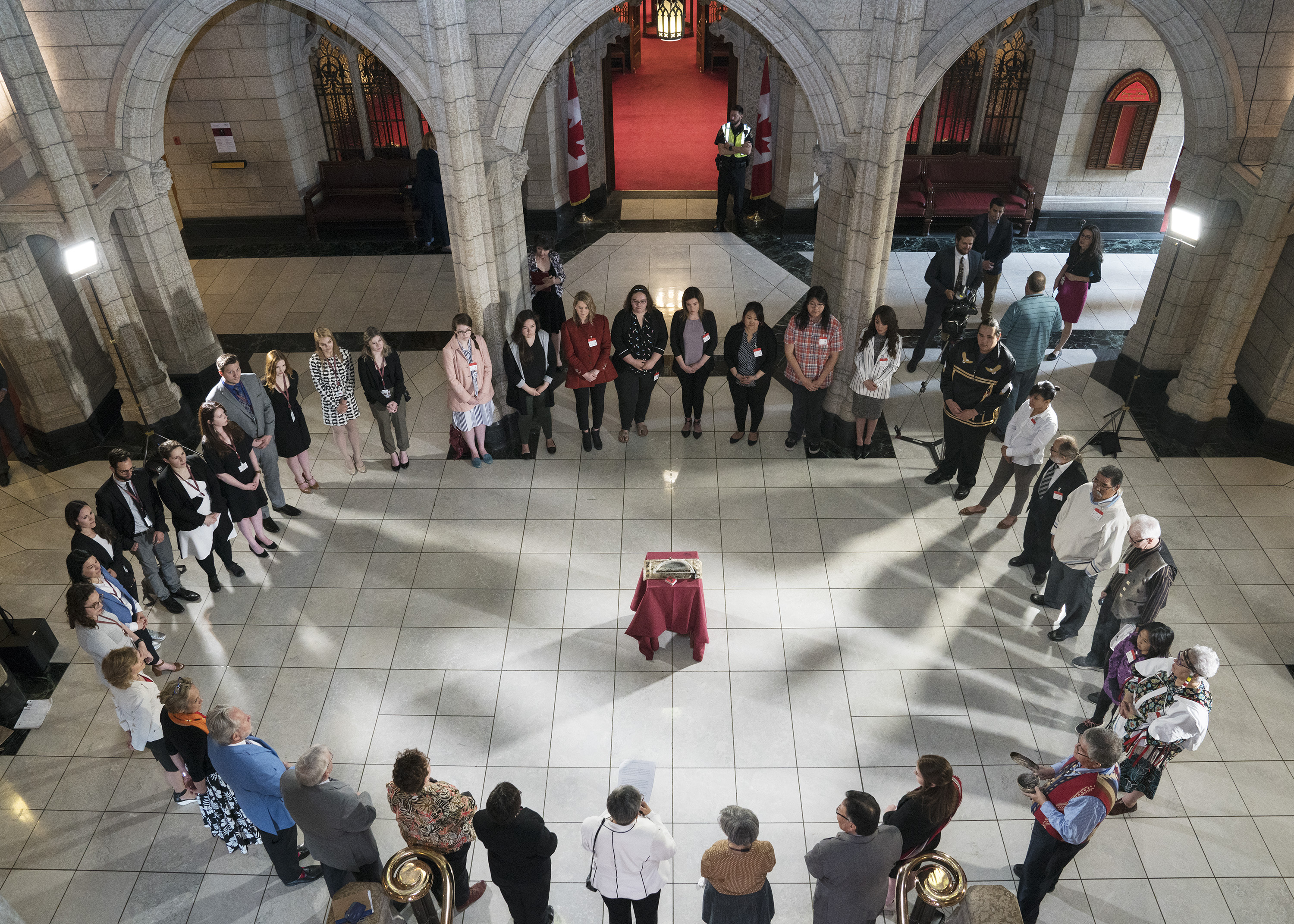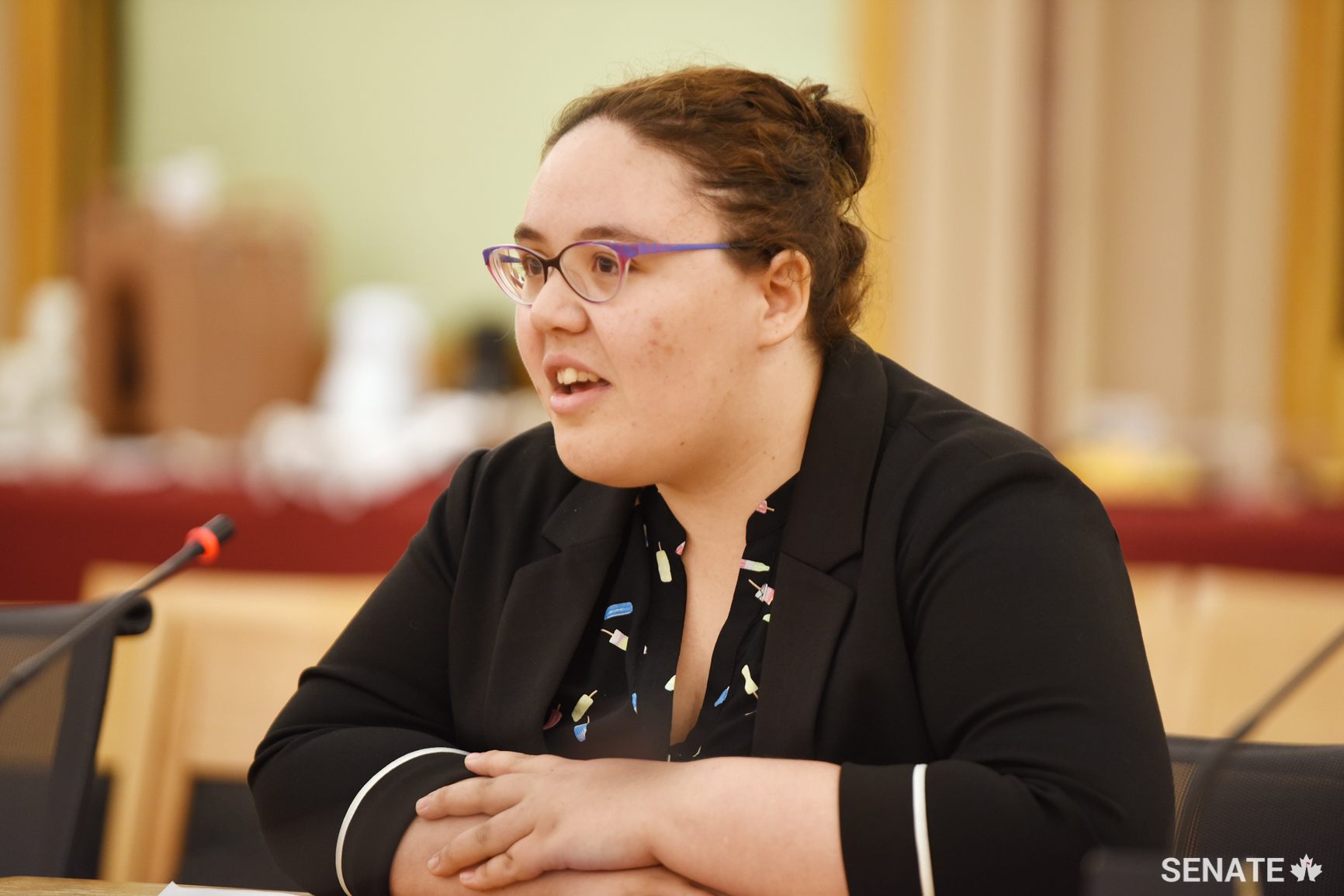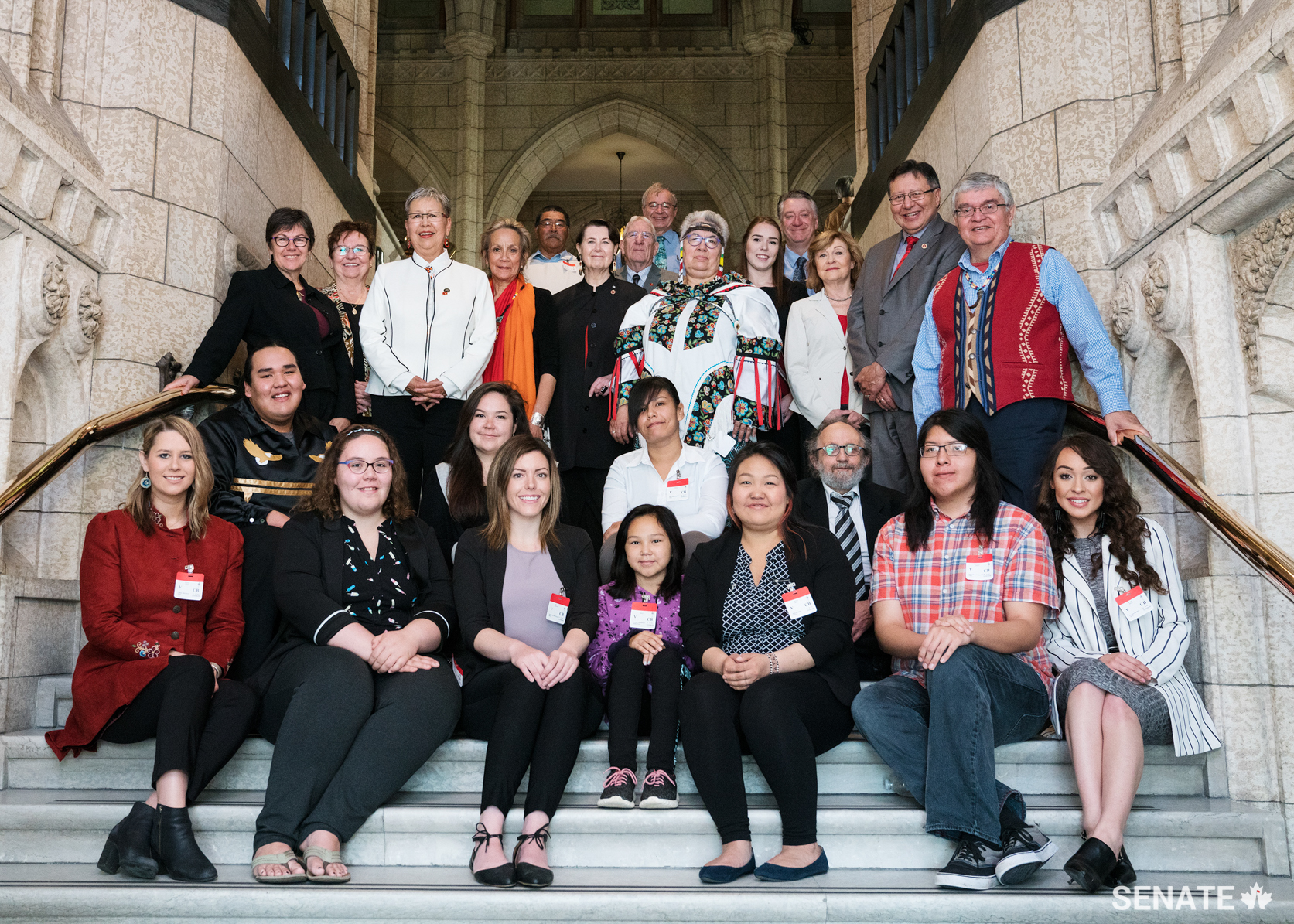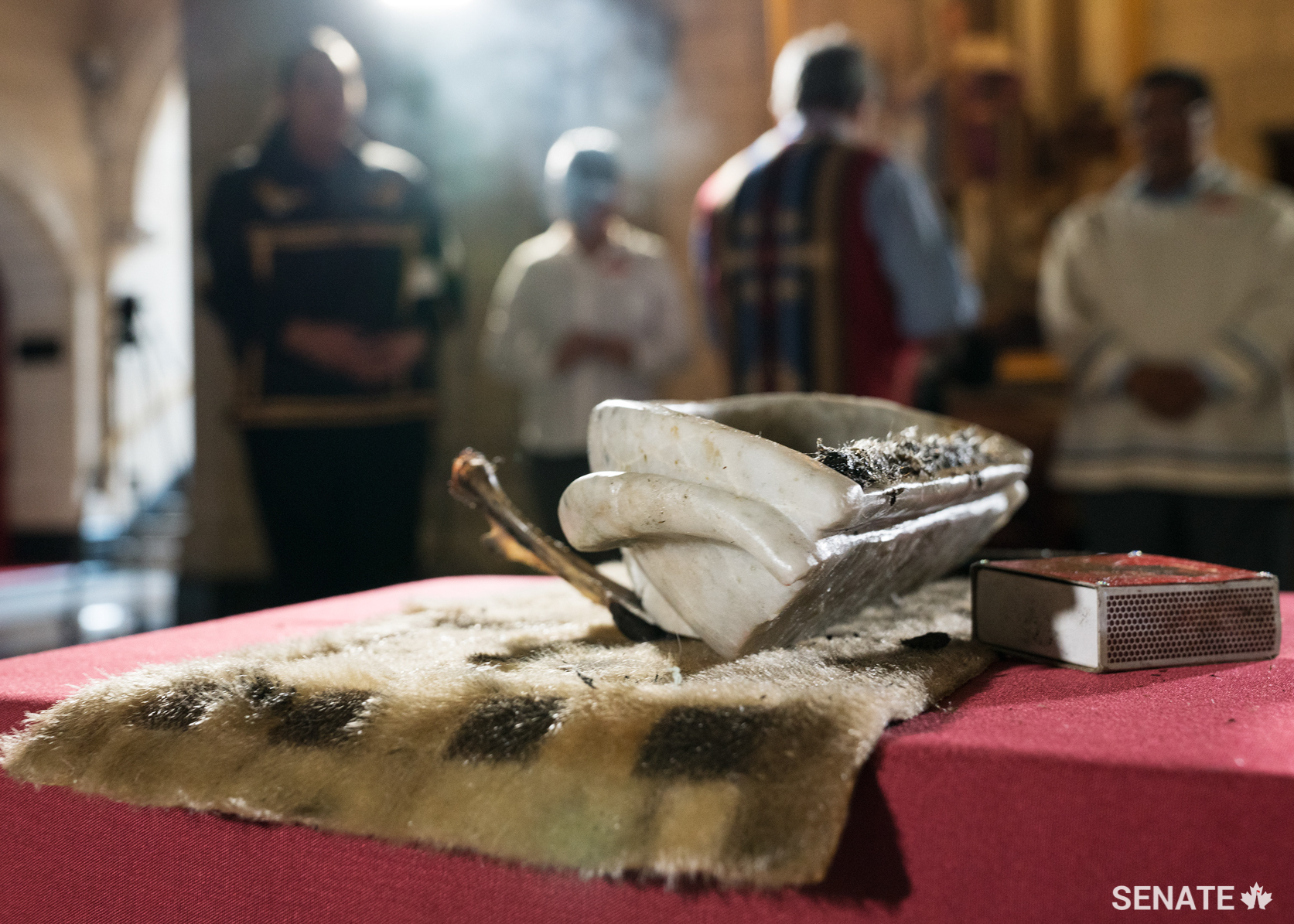Indigenous youth share their vision of a new relationship with Canada


Kayla Bernard still remembers the racial slurs she heard in primary school from other kids because they were often directed at her.
They were slurs that shocked her own mother when she came home from school asking what they meant.
“By the end of (first) grade primary school I could tell you 10 derogative words for a Native person that no six-year-old should know,” the Mi’kmaw youth said at the foot of the Peace Tower in Ottawa.
The discrimination didn’t just come from her peers. Even teachers, she said, wouldn’t let her read English in Grade 1 because they believed she wasn’t able to since she was Indigenous. Her dad had to go to the school and prove to the teaching staff that she could, in fact, read English.
“It’s a hard scar. I traded off a proper education for my emotional well-being. It’s left me with lasting trauma and lasting mental health effects from that bullying and that racism that I experienced,” the 22-year-old said.
Despite the bullying, Kayla has flourished and is now a leader in her community. She is a recreation therapy student at Dalhousie University who also sits on the youth advisory council for Wisdom to Knowledge, a government-funded initiative that aims to improve the mental health and well-being of vulnerable children and youth.
Her advocacy work with youth mental health earned her an invitation to Parliament Hill to testify before the Senate Committee on Aboriginal Peoples for Youth Indigenize the Senate on June 6, 2018.
The third annual event invited Indigenous youth from across the country to testify about their experiences as leaders and to share their visions of a new relationship between Canada and First Nations, Inuit, and Métis peoples, which is the focus of an ongoing committee study.

Eight other Indigenous youth gave powerful, firsthand accounts of what life as an Indigenous youth in Canada is really like. The committee whittled down a list of 150 nominees this year to nine individuals, choosing them based on their achievements in their communities and for advocating for the well-being of Indigenous peoples.
After the youth testified before the committee, senators asked them various questions, such as what their personal ambitions are and what they believe needs to be done at a federal level to improve the relationship between Canada and Indigenous peoples.
Some of the youth were brought to tears as they described the inter-generational trauma, youth suicide and homelessness that haunt Indigenous communities.
But each of the youth shared their own personal accomplishments within their communities. Rae-Anne Harper, 22, a Plains Cree and Métis woman, is now the president of the National Association of Friendship Centres Aboriginal Youth Council. She co-ordinated camps for at-risk urban Indigenous youth in Lloydminster, Saskatchewan.
Kieran McMonagle, a 28-year-old Métis mother of one, was the first First Nations, Inuit, and Métis student mentor in Ontario. Her efforts led to 50 % more Indigenous students graduating in her Dryden, Ont., high school this year.
Throughout the testimony, a central theme emerged — education, for, by and about Indigenous peoples.
Amanda Fredlund, a 27-year-old Tlicho Dene woman from Manitoba, said a new relationship would see every Canadian university offer a full Indigenous language degree. “That would mean different languages in the different provinces, of course, but that’s a very exciting thing,” she said.
Theoren Swappie, an 18-year-old Naskapi and Montagnais man from Quebec, said community members are often forced to leave their communities to access education, which may not be an accessible option due to a lack of funding.
And Ruth Kaviok, a 19-year-old Inuk woman from Nunavut, called for an education system that reflects Indigenous language, culture and values.
“Like our leaders who fought for our rights during the Quiet Revolution, I envision an Arctic where our youth are healthy both mentally and physically,” she told the committee.

Committee members said reaching out to youth is essential for the purpose of this crucial study.
“I was so moved listening to these youth testify and share personal accounts of inter-generational trauma and hardship. Indigenous youth are at the forefront of this ambitious study and they are such an inspiration to all Canadians,” said Senator Scott Tannas, deputy chair of the committee.
Committee member Senator Dan Christmas said it was an honour to hear their insights.
“It is my hope that their participation in this study will open the door to their own advocacy work in their own communities,” he said.
Committee Chair Senator Lillian Eva Dyck said youth are generally more engaged in what’s going on in their communities and offer unique perspectives on the core issues in the study.
“They are wise beyond their years and are very creative in their thinking,” Senator Dyck said. “Without their ideas for advancing the interests of Indigenous peoples, our study would lack the crucial insight that will lead to positive change.”
Kayla told the committee the government needs to find ways to empower Indigenous youth and guide them on a path to find a connection to their communities.
“I think our perspective is valuable because sometimes what we’ve been doing hasn’t been working,” she said. “It would be foolish for us to try and spend another 150 years in Canada doing the same thing.”
Watch a recording of the committee meeting or view a photo gallery of Youth Indigenize the Senate Day.
*Please note that as of July 31, 2022, the name of the Senate Committee on Aboriginal Peoples was changed to the Senate Committee on Indigenous Peoples. More information about this change can be found here.
Related articles
Tags
Committee news
Indigenous youth share their vision of a new relationship with Canada


Kayla Bernard still remembers the racial slurs she heard in primary school from other kids because they were often directed at her.
They were slurs that shocked her own mother when she came home from school asking what they meant.
“By the end of (first) grade primary school I could tell you 10 derogative words for a Native person that no six-year-old should know,” the Mi’kmaw youth said at the foot of the Peace Tower in Ottawa.
The discrimination didn’t just come from her peers. Even teachers, she said, wouldn’t let her read English in Grade 1 because they believed she wasn’t able to since she was Indigenous. Her dad had to go to the school and prove to the teaching staff that she could, in fact, read English.
“It’s a hard scar. I traded off a proper education for my emotional well-being. It’s left me with lasting trauma and lasting mental health effects from that bullying and that racism that I experienced,” the 22-year-old said.
Despite the bullying, Kayla has flourished and is now a leader in her community. She is a recreation therapy student at Dalhousie University who also sits on the youth advisory council for Wisdom to Knowledge, a government-funded initiative that aims to improve the mental health and well-being of vulnerable children and youth.
Her advocacy work with youth mental health earned her an invitation to Parliament Hill to testify before the Senate Committee on Aboriginal Peoples for Youth Indigenize the Senate on June 6, 2018.
The third annual event invited Indigenous youth from across the country to testify about their experiences as leaders and to share their visions of a new relationship between Canada and First Nations, Inuit, and Métis peoples, which is the focus of an ongoing committee study.

Eight other Indigenous youth gave powerful, firsthand accounts of what life as an Indigenous youth in Canada is really like. The committee whittled down a list of 150 nominees this year to nine individuals, choosing them based on their achievements in their communities and for advocating for the well-being of Indigenous peoples.
After the youth testified before the committee, senators asked them various questions, such as what their personal ambitions are and what they believe needs to be done at a federal level to improve the relationship between Canada and Indigenous peoples.
Some of the youth were brought to tears as they described the inter-generational trauma, youth suicide and homelessness that haunt Indigenous communities.
But each of the youth shared their own personal accomplishments within their communities. Rae-Anne Harper, 22, a Plains Cree and Métis woman, is now the president of the National Association of Friendship Centres Aboriginal Youth Council. She co-ordinated camps for at-risk urban Indigenous youth in Lloydminster, Saskatchewan.
Kieran McMonagle, a 28-year-old Métis mother of one, was the first First Nations, Inuit, and Métis student mentor in Ontario. Her efforts led to 50 % more Indigenous students graduating in her Dryden, Ont., high school this year.
Throughout the testimony, a central theme emerged — education, for, by and about Indigenous peoples.
Amanda Fredlund, a 27-year-old Tlicho Dene woman from Manitoba, said a new relationship would see every Canadian university offer a full Indigenous language degree. “That would mean different languages in the different provinces, of course, but that’s a very exciting thing,” she said.
Theoren Swappie, an 18-year-old Naskapi and Montagnais man from Quebec, said community members are often forced to leave their communities to access education, which may not be an accessible option due to a lack of funding.
And Ruth Kaviok, a 19-year-old Inuk woman from Nunavut, called for an education system that reflects Indigenous language, culture and values.
“Like our leaders who fought for our rights during the Quiet Revolution, I envision an Arctic where our youth are healthy both mentally and physically,” she told the committee.

Committee members said reaching out to youth is essential for the purpose of this crucial study.
“I was so moved listening to these youth testify and share personal accounts of inter-generational trauma and hardship. Indigenous youth are at the forefront of this ambitious study and they are such an inspiration to all Canadians,” said Senator Scott Tannas, deputy chair of the committee.
Committee member Senator Dan Christmas said it was an honour to hear their insights.
“It is my hope that their participation in this study will open the door to their own advocacy work in their own communities,” he said.
Committee Chair Senator Lillian Eva Dyck said youth are generally more engaged in what’s going on in their communities and offer unique perspectives on the core issues in the study.
“They are wise beyond their years and are very creative in their thinking,” Senator Dyck said. “Without their ideas for advancing the interests of Indigenous peoples, our study would lack the crucial insight that will lead to positive change.”
Kayla told the committee the government needs to find ways to empower Indigenous youth and guide them on a path to find a connection to their communities.
“I think our perspective is valuable because sometimes what we’ve been doing hasn’t been working,” she said. “It would be foolish for us to try and spend another 150 years in Canada doing the same thing.”
Watch a recording of the committee meeting or view a photo gallery of Youth Indigenize the Senate Day.
*Please note that as of July 31, 2022, the name of the Senate Committee on Aboriginal Peoples was changed to the Senate Committee on Indigenous Peoples. More information about this change can be found here.


